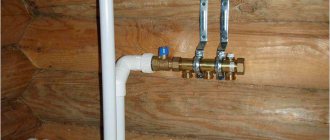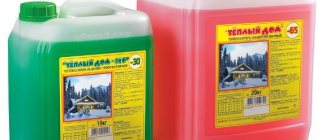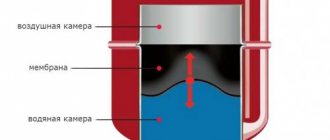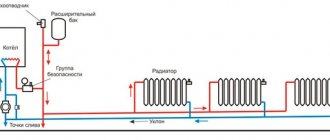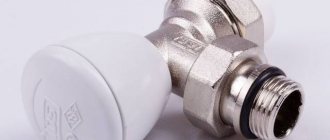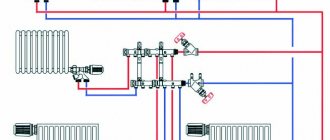The heating system must be economical and efficient. It should be designed and installed correctly. Otherwise, in winter you will have to suffer from the cold not only outside, but also inside your home. There are several ways to heat a private house with your own hands. The classic version of its design is an electric or gas boiler plus one-pipe or two-pipe wiring. But other combinations are also possible. In order to correctly choose the most suitable scheme, you should thoroughly understand all their features.
Single-pipe schemes
The easiest way to calculate and assemble a heating system is with a single-pipe piping scheme for the coolant. The heated water in it sequentially passes from the boiler through all the radiators in the house, starting with the first and ending with the last in the chain. At the same time, each subsequent radiator receives less and less heat.
There are four main advantages of such a heating installation in a private house:
- Ease of implementation;
- Small cubic capacity of coolant;
- Hydraulic stability of the system;
- Low consumption of materials.
Installing a pipeline according to this scheme and connecting it to the boiler with your own hands, even if you have minimal skills, can be completed in two to three days. Plus, the costs of creating a water heating system in a house for single-pipe wiring are minimal compared to other options.
Few fittings, fittings and pipes are required here. The savings on materials are significant. And it doesn’t matter whether laminated timber or brick is chosen for the construction of the cottage. If the home is well insulated, then even a simple one-pipe system for heating it will be more than enough.
Among the weak points of this heating scheme are:
- Inability to accurately regulate the heat supply in each room;
- Limitation on the total length of the pipeline throughout the house (no more than 30 m);
- Small amount of thermal energy in the battery furthest from the boiler;
- Vulnerability to defrosting and gusts.
To mitigate the shortcomings, a circulation pump has to be built into a single-pipe system. But these are additional costs and potential equipment breakdowns. Plus, if there are any problems in any section of the pipe, heating of the entire cottage stops.
Single-pipe horizontal
If a private house is small and one-story, then a single-pipe heating system is best done in a horizontal design. To do this, a ring of one pipe is laid in the rooms around the perimeter of the cottage, which is connected to the inlet and outlet of the boiler. Radiators cut into the pipeline under the windows.
Single-pipe horizontal design - ideal for small spaces
The batteries are connected here using a bottom or cross connection. In the first case, heat losses will be at the level of 12–13%, and in the second they are reduced to 1–2%. It is the cross installation method that should be preferred. Moreover, the coolant supply to the radiator should be done from above, and the outlet from below. So the heat transfer from it will be maximum, and losses will be minimal.
Single-pipe vertical distribution
For a two-story cottage, a single-pipe vertical heating system is more suitable. In it, the pipe from the water heating equipment goes up to the attic or second floor, and from there it goes back down to the boiler room. In this case, the batteries are also connected in series one after the other, but with a side connection. The pipeline for the coolant is usually laid in the form of a single ring, first along the second and then along the first floor, in such a heating distribution in a low-rise building.
Single-pipe vertical design - saving on materials
But an example with vertical branches from a common horizontal pipe at the top is also possible. That is, first a circular circuit is made from the boiler up, along the second floor, down and along the first floor back to the water heater. And between the horizontal sections, vertical risers are laid with radiators connected to them.
The coldest battery in such a heating system for a private house will again be the last one in the chain - at the bottom of the boiler. In this case, there will be an excess of heat on the upper floor. It is necessary to somehow limit the volume of heat transfer at the top and increase it at the bottom. To do this, it is recommended to install bypass jumpers with control valves on the radiators.
Leningradka
Both schemes described above have one common disadvantage - the temperature of the water in the last radiator turns out to be very low, it gives off very little heat to the room. To compensate for this cooling, it is recommended to improve the single-pipe horizontal heating option for a private house by installing bypasses at the bottom of the battery.
Leningradka - improved single-pipe system
This wiring was called “Leningradka”. In it, the radiator is connected from above to a pipeline running along the floor. Plus, taps are placed on the outlets to the batteries, which can be used to regulate the volume of incoming coolant. All this contributes to a more even distribution of energy across individual rooms in the house.
Two-pipe wiring
Such systems can be no less efficient than single-pipe ones. This method is suitable for heating houses with one and two floors. Its difference is that you can independently change the temperature in any room.
Another feature of the two-pipe type system is the fact that the forward and return circuits are separated from each other.
The heated liquid is supplied to the system through supply channels. Water begins to flow through the inlet pipes to the batteries. It can also be applied to heated floors. After the liquid has cooled, it is automatically withdrawn. Such systems have one positive feature - how water flows to certain batteries can be adjusted manually.
The overhead wiring can be invisible if you install the pipes above the doorways and cover them with decorative elements. In this case, the pipes will be camouflaged as much as possible.
A disadvantage of the top wiring can be considered the fact that, in addition to installing pipes, it is necessary to install a membrane expansion tank. This kind of work is easy to do, but it will require more money.
If the system is installed in a building with two floors, an open tank can be installed. However, it can only be placed in the attic. With lower wiring, the pipes will be located below the window sill.
This method is a little more difficult to implement, since, in addition to installing pipes, you will have to install an open expansion tank. It must be installed above the placement of straight pipes.
Vertical scheme with top wiring
When choosing this model, the coolant will go to the attic from the heating device. The liquid then goes to all the batteries in the house.
Attention! You can prevent the system from becoming airy by removing air from time to time. For this purpose it is necessary to install an expansion tank.
Such schemes are more effective for lower wiring. This is due to the high pressure supplied through the risers.
Bottom wiring of vertical type
A two-pipe heating system with bottom wiring is created sequentially:
- A main pipeline must be laid along the floor of the basement or first floor. It will originate from the boiler.
- It is necessary to run vertical pipes along the main pipe, which will ensure the movement of coolant to the batteries.
When designing a two-pipe heating system with bottom wiring, it is necessary to decide how air will be removed from the pipeline. This requirement can be satisfied by installing an air pipe and an expansion tank.
Horizontal system
The horizontal wiring option, in which the coolant circulates forcibly, is quite popular. There are several schemes:
- Dead end. The advantages of these systems include savings in pipe consumption. The disadvantages include too long a contour. Due to this, it becomes significantly more difficult to regulate the operation of the system as a whole.
- Associated movement of coolant. Each circulation circuit is of equal length, making system adjustment simple and easy. The disadvantage of such a system is that the pipe flow is too high. In addition, the interior of the rooms deteriorates when such a system is installed.
- Radiation or collector distribution of heating pipes in a private house. Each battery is connected to a central collector. Due to this, heat distribution is uniform.
When installing a beam system, you will have to spend money on pipes.
Two-pipe heating systems
In a two-pipe heating system, the batteries are no longer connected to one common line, but to two - supply and return. This way the heat distribution throughout the building occurs more evenly. The water reaches each heat exchanger at approximately the same temperature. It is not for nothing that such a scheme is usually used in high-rise buildings with a large number of heated rooms. But it is also often installed in cottages, especially if they are large and have several floors.
The two-pipe heating system has the following advantages:
- Possibility of precise adjustment of room temperature;
- Uniformity of heat distribution in individual rooms;
- High operational reliability;
- It is permissible to repair one battery while continuing to operate the entire system.
The two-pipe heating scheme for private houses has only one serious drawback - price. Its high cost is often mentioned in comparison with its single-pipe analogue. However, pipes in this case require a smaller diameter. Their length doubles here. At the same time, due to the reduction in cross-section, the final estimate turns out to be not as inflated as it might seem at first glance.
By analyzing the types of foundations, we can immediately say unequivocally that a monolith will be more expensive than a strip foundation. When arranging heating for private houses, everything is not so simple and easy. When installing it, pipes of different diameters, various fittings and thermostats are used. The total cost of each variety must be calculated individually for the actual structure and for the specific parameters of the required temperature regime.
With bottom wiring
With the bottom scheme, both pipes are laid above or in the floor. And a pair of taps are connected to the batteries from below. This type of connection is often used to hide heating pipelines behind finishing. This is more of a design decision; it does not provide any special advantages in terms of heat transfer.
Two-pipe with bottom wiring
On the contrary, the lower method of connecting radiators involves the highest heat loss. It is generally not recommended for use in heating systems with natural (gravity) circulation. If this wiring is chosen, you will have to take care of the availability of special equipment for pumping the coolant, and choose a battery with more power. A boiler without a circulation pump cannot supply heat throughout the house alone.
With top wiring
In the upper heating distribution, the connection of radiators to the pipes can be diagonal or lateral. This is not the most important thing here. The main distinguishing feature of this type of water heating is the presence of an expansion tank.
Two-pipe with top wiring
The expansion tank is placed in the attic. The water heated in the boiler actually first enters this storage tank. The coolant flows into the supply pipe naturally from top to bottom. And then the water, after releasing heat in the radiator, is sent through the return line back to the heater.
Methods of water circulation in heating systems
The movement of liquid along a closed circuit (circuits) can occur in a natural or forced mode. Water heated by the heating boiler rushes to the radiators. This part of the heating circuit is called forward stroke (current). Once in the batteries, the coolant cools down and is sent back to the boiler for heating. This period of the closed route is called the return stroke (current). To speed up the circulation of the coolant along the circuit, special circulation pumps are used, embedded in the pipeline at the “return”. Models of heating boilers are produced, the design of which provides for the presence of such a pump.
Natural coolant circulation
With natural circulation, the movement of water in the system occurs by gravity. This is possible due to the physical effect that appears when the density of water changes. Hot water has a lower density. The liquid flowing in the reverse direction has a high density, and therefore easily displaces the water that has already heated up in the boiler. The hot coolant rushes up the riser, and is then distributed along horizontal lines laid at a slight slope of no more than 3-5 degrees. The presence of a slope allows liquid to move through the pipes by gravity.
The heating scheme, based on the natural circulation of the coolant, is the simplest and therefore easy to implement in practice. In addition, in this case, no other communications are required. However, this option is only suitable for small private houses, since the length of the contour is limited to 30 meters. Disadvantages include the need to install larger diameter pipes, as well as low pressure in the system.
Scheme of an autonomous heating system for a house with natural circulation of water (coolant). The pipeline is laid at a slope of no more than 5 degrees
Forced coolant circulation
In autonomous heating systems with forced circulation of water (coolant) in a closed circuit, there is a mandatory circulation pump, which provides an accelerated flow of heated water to the batteries, and cooled water to the heating device. The movement of water is possible due to the pressure difference that occurs between the forward and reverse flow of the coolant.
When installing this system, it is not necessary to observe the slope of the pipeline. This is an advantage, but a significant disadvantage lies in the energy dependence of such a heating system. Therefore, in case of a power outage, a private home must have a generator (mini-power plant), which will ensure the functioning of the heating system in an extreme situation.
A diagram of the organization of a home heating system, in which the circulation of the coolant is ensured by a circulation pump embedded in the return flow pipeline
A circuit with forced circulation of water as a coolant can be used when installing heating in a house of any size. In this case, a pump of suitable power is selected and its uninterrupted power supply is ensured.
Beam system
The collector (radiant) heating scheme is the most advanced and modern in terms of thermal efficiency. In it, each of the radiators is connected to a pair of pipes from two common collectors for the floor, which are themselves connected to the boiler equipment. Temperature control with this wiring is more flexible. Plus, it is permissible to connect not only batteries to the collectors, but also a “warm floor”.
Among the advantages of such a heating system for a private house, the following should be noted:
- Convenient and flexible adjustment;
- High efficiency of thermal energy distribution;
- Possibility of replacing individual elements without turning off the heating as a whole.
In this case, the pipelines can be laid as desired. Often they are simply laid under the poured floor. The main disadvantage of the beam scheme is the high cost of the system as a whole and the long length of the pipes. Plus, it will be difficult to lay the latter in large quantities in an already finished cottage. Their installation should be planned in advance at the stage of designing a home.
Radial design - ideal heat distribution
This slate, if necessary, can be relatively easily replaced with another roofing material. The layout of the heating pipes is more complicated; changing it later is not so easy. Even the rigid dimensions of the ondulin sheet are not so scary; there are a lot of scraps, but this is only a slight increase in the roof estimate. With heating pipelines, especially for radial distribution, everything is much more complicated.
Types of autonomous heating systems
All heating systems are, first of all, classified according to the type of fuel that is used to heat the coolant. The best option is combination boilers, which allow the use of several types of fuel or energy sources.
A striking example is solid fuel boilers with the ability to connect gas or electricity. There are models on the market that combine several methods of increasing the temperature of the coolant - gas, electricity, solid or liquid fuel.
Such boilers are endowed with all the advantages of standard devices operating on one type of fuel. However, they increase many times over, since several types are combined in one device. Now let's look at the types of heating systems in more detail.
Water heating system with a modern radiator Source www.remontnik.ru
Water heating
This type is the most common. The relative ease of installation and availability of the coolant - water, will retain the relevance of water heating for many years to come. To ensure optimal heating, various installation schemes are used. This can be a two-pipe heating system or a single-pipe heating system.
Radiators made of cast iron or steel act as heat exchangers in such systems. Also, bimetallic equipment or converter-type batteries are popular. The pipeline is made of metal or special plastic. Almost any heating boiler can be integrated into such a system.
Advantages:
- the ability to control the temperature of system components;
- the possibility of installing a pipeline of a smaller cross-section relative to a steam and air heating system;
- high degree of safety during operation;
- fairly low financial costs and minimal requirements for the quantity of consumables;
- no noise during operation;
- uniform heating of all components included in the system.
"Leningrad heating" wiring Source aquasistem.ru
Disadvantages:
- the likelihood of clogging the system with air locks;
- the need for constant monitoring for the performance of the thermal energy source;
- when using metal communications, there is a high probability of corrosion;
- when using old-style radiators, the system warms up slowly;
- difficulties during installation work;
- sensitivity to low ambient temperatures with the risk of system defrosting.
Air heating
In such systems, the room is heated by air flow. Ambient air is taken in by intakes and supplied to the heating element of the system. It can be gas or electric equipment. A water heat exchanger can also be used.
The heated air is forced into the room by means of a fan. When a new portion is taken in, already heated air from the rooms is mixed with fresh air from the street. To do this, it is advisable to install a filter element in the system that will trap dust and other unwanted fractions.
The process is performed cyclically until the room temperature is raised to the required level. The thermostat installed in the system switches off at the desired level and turns on the equipment when it deviates minus one degree.
House air heating diagram Source build-experts.ru
Air heating systems offer high flexibility for the installation of various modules and add-ons. If you install a water cooler or an evaporator from an air conditioner in a channel with a heater, then in the summer you can use communications to create coolness in the room.
If there is a heat pump function in the air conditioner evaporator, in winter this circuit is also used as a heating element. The air supply channel itself can be equipped with a humidifier, sterilizer, ionizer and many other additional devices.
Advantages:
- the ability to install all types of air treatment at “one point”, from filtration to humidification.
- additional operating mode options – air conditioning or heat pump;
- due to controlled ventilation, up to 30% of energy resources are saved in relation to other types of heating;
- excellent comfortable characteristics combining heating, ventilation and air filtration as standard equipment;
- temperature control using a thermostat can be done via the Internet;
- the system is not afraid of low temperatures, has high reliability and a long service life;
- ease of use, since all elements of the system are easily accessible and can be quickly replaced.
Air heating using a fireplace Source stroikairemont.com
Disadvantages:
- most of the work on installing the system should be planned at the building design stage;
- air communications require a certain space in the internal volume of the room.
Natural and forced heating circulation
It doesn’t matter whether gas, wood, coal or electric heating is planned to be installed in a private house. In any case, there is a boiler (furnace or water heater) for heating the coolant, as well as pipes for its movement along the circuit. In this case, water in pipelines can flow naturally under the influence of gravity and convection or forcibly using a pump.
Scheme of types of heating circulations
The first example is cheaper and quieter than the second. However, forced circulation can greatly improve the performance of the entire heating system. Often, heating a private home cannot be done without a booster pump. Due to the large number of radiators, pipe turns and fittings, the hydraulic resistance in the pipeline is too high. And this can only be compensated for by the operation of pumping equipment.
We draw up a heating project
To carry out heating in a private house with your own hands, you will definitely need a project . It must be compiled in the following order:
- First make a sketch of the house.
- Then carry out zoning of the house and determine the degree of comfort of each room.
- Calculate heat loss for all rooms separately.
- Design the placement of batteries in each room.
- Determine the number of sections required for each radiator.
- Select heating scheme.
- Calculate the boiler power, the required amount of materials (meterage of pipes, number of tees, valves, automation, etc.).
There shouldn’t be any problems with the house sketch, so let’s move straight to the comfort zones.
IMPORTANT! It is extremely difficult to do the entire amount of work yourself, so we recommend that you find out the prices for installing heating in a private home from various companies. This way, it will be easier for you to figure out what work can be outsourced to the experts, and what work is better to do yourself.
Zoning the premises
Proper distribution of heat will not only allow you to feel comfortable at home, but can also save you some money. So, what temperature is best to maintain in different rooms:
Correctly plan the thermal zones of your home for comfortable living in it.
- The overall comfort temperature should be between 20-24 degrees.
- For the bedroom, it is better to slightly raise the temperature and set it within 22-25 degrees.
- For the bathroom, toilet, guest room and rooms where you are most of the time, the temperature range will be from 21 to 24 degrees.
- For the dining room, kitchen, office, it is better to reduce the temperature to 18-22 degrees.
- For the hallway, garage and passage area, you can set a limit of 12 degrees.
Calculating heat loss
The calculation can be simplified without taking into account the internal heat exchange between rooms. When making calculations, it is important to determine the number of external walls and corners; this is where the greatest losses occur. The amount of loss can be calculated by taking the data from the table below and multiplying it by the thickness of the wall.
By thermal resistance
| Wall material and thickness | Rt |
| Brick wall 3 bricks thick (79 cm) | 0,592 |
| Brick wall 2.5 bricks thick (67 cm) | 0,502 |
| Brick wall 2 bricks thick (54 cm) | 0,405 |
| Brick wall 1 brick thick (25 cm) | 0,187 |
| Log house diameter 25 cm | 0,55 |
| Log house with diameter 20 cm | 0,44 |
| Log house made of timber 20 cm thick | 0,806 |
| Log house made of timber 10 cm thick | 0,353 |
| Frame wall (board+mineral wool+board) 20 cm | 0,703 |
| Foam concrete wall 20 cm | 0,476 |
| Foam concrete wall 30 cm | 0,709 |
| Plaster 2-3 cm | 0,035 |
| Ceiling (attic) floor | 1,43 |
| Wooden floors | 1,85 |
| Double wooden doors | 0,21 |
According to the given heat losses
Specific heat loss of building enclosure elements (per 1 m2 along the internal contour of the walls) depending on the average temperature of the coldest week of the year
| Fencing characteristics | Outside temperature, °C | Heat loss, W/m2 |
| Double glazed window | -24 | 117 |
| -26 | 126 | |
| -28 | 131 | |
| -30 | 135 | |
| Solid wooden doors (double) | -24 | 204 |
| -26 | 219 | |
| -28 | 228 | |
| -30 | 234 | |
| Attic floor | -24 | 30 |
| -26 | 33 | |
| -28 | 34 | |
| -30 | 35 | |
| Wood floors above basement | -24 | 22 |
| -26 | 25 | |
| -28 | 26 | |
| -30 | 26 |
IMPORTANT! A large amount of heat escapes through the windows.
Batteries
The choice of radiators is very important. Not only the durability of the heating system depends on this, but also the heat levels in your home. There are only 4 types of batteries:
- cast iron;
- steel;
- aluminum;
- bimetallic.
Bimetallic radiators consist of strong steel pipes and an aluminum jacket that transfers heat well.
Cast iron radiators give off heat best and last the longest. But they are difficult to install due to their significant weight. An excellent choice would be bimetallic batteries . They are durable, give off heat well, but are more expensive than other options. It is better not to install aluminum and steel ones, since aluminum is short-lived, and steel will not be able to cope with heating the rooms in severe frost.
To correctly calculate the number of radiator sections per room, you need to multiply the number of heat losses by 1.2 (safety factor) and divide by the thermal power of the battery section. The value should be rounded up.
On a note! Alternative option. In order not to bother yourself with calculations, you can calculate the number of sections like this: for every 2 sq. m of room (with a ceiling height of up to 3 m) one section is needed. If heat loss is high, then take a couple of sections in reserve.
The principle of operation of the “screen” for the battery.
It is better to install batteries under a window. This move will somewhat reduce heat loss through the window opening. But in this case, the battery will transfer some of its heat to the wall, which you do not need at all. Therefore, we recommend installing a “screen” on the wall where the radiator is installed . It is usually made of foil and serves as a heat reflector. The warm flow is reflected and returned to the room, heating the air, not the wall.
After all the calculations, you need to choose the heating scheme, which was already mentioned earlier. Our choice remains unchanged - we recommend a two-pipe one.
Boiler power calculation
It is worth noting that it is better to take the power parameter with a small margin , this way you will protect yourself in severe frost. The heating device will calmly cope with an emergency situation.
To calculate the power, you need to add up the power of all radiators (possibly other devices that will be powered by the boiler), multiply this value by 1.4 (this is a coefficient that takes into account heat loss through ventilation). The resulting figure must be divided by the power utilization factor and the boiler efficiency. Then select the boiler from the table that best matches the resulting value.
Latest pieces
When all the calculations are made, you need to measure all the distances in order to buy the required number of pipes and tees. Take everything with a small margin. Buy a boiler, coordinate all the necessary documents, purchase radiators and other consumables.
Which home heating system to choose
There are several types of heating systems. They differ in pipe layout, methods of connecting radiators and how the coolant moves through them. Competently choosing the most effective option is possible only if you have knowledge of heating engineering. It is necessary to make complex calculations and prepare a project. For a small cottage, a simple one-pipe scheme is quite suitable. In other cases, it is better to delegate the design to a professional. But the installation work can be done independently.
Video description
This video will show you how to make a manifold for a heated floor with your own hands:
A collector heating system, also known as a radiant heating system, consists of the following elements:
- collector;
- pump;
- heating devices;
- safety devices;
- expansion tank;
- pipeline;
In turn, the collector assembly is mounted in two parts:
- Input - it is connected to the heating unit, receiving the coolant at the required temperature, and distributes it along the circuits of the system.
- Output - return circuits are connected to it, which release the cooled coolant, which is redirected to the boiler for the next heating.
The main difference and advantage of this installation method is the ability to independently connect heating devices to the system. This allows you to simplify repair work and more accurately regulate the temperature in the room. The disadvantage is the high costs of communication and installation.
Leningradka system
Another interesting solution is the Leningrad heating system. The Leningradka heating system in a private house allows you to level out heat loss by the coolant when moving away from the boiler.
This is the main problem of classical type heating systems - achieving the same temperature along the entire length of the line. To solve this problem, it is necessary to increase the number of heating devices as they move away from the heat source.
Radiator installed according to the “Leningradka” scheme Source plusteplo.ru
Schemes with different coolant supply to radiators
Depending on the position of the risers for supplying water to the batteries, vertical and horizontal wiring are distinguished. In private one-story houses, a horizontal wiring diagram is used. During installation, water inlet and outlet pipes can be successfully integrated into the interior, hidden in niches or under the floor.
The flow of hot and chilled water in the heating system of a private home can be installed using one or two pipes. Each option has nuances of the wiring type, positive aspects and disadvantages.
Single-pipe scheme
This is an easier to install and cheaper option. The heating system with one pipe is a ring with installed radiators. Warm water moves around the perimeter and eventually returns to the boiler. The coolant transfers several degrees of heat to each radiator. This means that the further the heating device is located from the boiler, the lower the water temperature and the ability to heat the room. You can increase water heating. This will require more fuel consumption. Installing a circulation pump will help move water at a faster speed and distribute heat evenly. The optimal solution with this scheme would be to increase the number of sections of the last batteries in the line.
Radiators are usually connected through a bypass (bypass pipe), which will allow you to turn off any of them without stopping the flow of coolant. The system does not require the installation of fittings and taps, which minimizes the risk of accidents.
Advantages of the scheme:
- minimizing the pipe perimeter;
- savings on system elements;
- fast, easy installation.
Two-pipe scheme
Installing heating in a private house using two pipes works more efficiently. With this scheme, each radiator has a separate coolant supply from the heat main, but the heat main, as in the previous case, is the same for the entire system. The difference is that radiators are connected to the systems in parallel, rather than in series.
The system has one return flow line - a separate pipe departs from each battery to remove the coolant.
We invite you to watch a detailed video about the nuances of installing a two-pipe heating system in a house:
Beam system
The collector beam system involves the installation of a collector through which the coolant is distributed throughout the system. Each heating battery has its own pipes for supplying coolant and discharging it directly from the boiler. Each circuit is cut off by shut-off valves. This makes the system easier to use and repair. Without disconnecting the entire system, you can repair a separate circuit or radiator.
The downside is significant costs for materials. You will need shut-off valves, pipes, adjustment devices, and monitoring sensors.
The radial circuit with a distributor operates under good pressure in the pipe created by a circulation pump.
The collector evenly distributes the coolant flow. The device consists of two combs. One receives hot water from the boiler. Another comb collects the cooled water and sends it back to the boiler. How to calculate heating in a private house with this scheme?
Calculating parameters, drawing up a project, and regulating power during use are facilitated by connecting radiators in parallel. This ensures a minimum difference in water temperatures around the perimeter of the circuit. The system is controlled from one place with installed indicators, taps, pumps and valves.
Installation of a beam system is the most expensive in terms of the total cost of components and requires certain qualifications. You should draw up a project and install radiant heating during construction or general renovation. This is due to the fact that the pipes are installed in the floor screed.
Almost everyone needs basic knowledge about the operating principle of the heating system. This will allow you to find this or that problem in a short time, as well as avoid errors during installation and design. In this article you will learn all the most interesting things about the operating principle of water heating systems.
What does a water heating system consist of?
Experts call such systems hydraulic or liquid. The fact is that thermal energy is directed to heating devices from the boiler. These devices may include: heated floors, radiators and many others. The circulation process takes place in a pipeline with heated water. In other words, a water heating system is a closed chain that consists of pipes, heating devices, and a boiler. In addition, you can include elements such as: nuts, taps, tank, security system and much more.
Heating system operation
The heating system works as follows: The heated liquid in the boiler moves through the system, the heat is distributed through the pipes to the appliances, after which it is supplied to heat the room. Since all heating elements are a closed system, the liquid moves in a circle.
Main types of heating systems
The heating system is divided into two groups according to the method of circulation of the coolant:
- From the pump. Forced circulation.
- Convective system. Natural circulation.
We can look at the operation of each system in this article.
Heating system with natural circulation
This system is the simplest, although its installation can hardly be called such.
The coolant is heated in the boiler. This process leads to a decrease in the density of the water, after which it moves up the pipe, which is called the supply riser. The liquid is forced into the expansion tank, where its volume increases significantly. Next, it is sent down the pipes, which are called horizontal risers. Then the water ends up in the heating device. Here it regains its density, which allows it to flow down to be returned to the cauldron.
It is worth noting that vertical risers must be of large diameter. This allows the formation of a motivating force leading to the circulation of the coolant.
In such a heating system, slopes must be taken into account.
First of all, you need a slope towards the heating device from the riser. Then, a slope is needed in the “return” to the boiler. If there is no slope, the system will not work.
Heating system with forced circulation
For this system to operate, it is necessary to use a circulation pump. There are various models of such pumps, which differ from each other in their power.
Paying attention to the diagram shown below, you can see the heating of the coolant in the boiler. Thanks to the pump, water moves through the pipes to the heating devices. In addition, there are valves on each radiator. They allow you to set a more comfortable temperature. Nowadays, you can use manual or automatic valves.
Almost all radiators are equipped with special taps through which air can be removed from the system. The operating principle of this system is similar to the previous one. The cooled water is returned through the pipe back to the boiler.
To choose a heating system for your home, you need to highlight their disadvantages and advantages.
Pros and cons of heating systems
The two above systems have their pros and, of course, cons. Let's take a closer look at them.
Advantages of a heating system with forced circulation:
- It is possible to adjust the heat flow in automatic mode.
- It has the ability to set the temperature regime for each room separately. It will also be maintained automatically.
- Thanks to automatic mode, fuel consumption is more economical.
- You can use plastic pipes, which will reduce installation costs and the cost of purchasing material.
- Plastic pipes do not spoil the interior of the room. In addition, they can be hidden in the wall.
The disadvantage of forced circulation is that the operation of the entire system depends on electricity. We must not forget that the operation of the pump is ensured by the electrical network.
Advantages of a heating system with natural circulation
It has the only advantage - it does not depend on electricity. This system does not use a pump.
Disadvantages of a heating system with natural circulation:
- There is no way to adjust the heat automatically.
- High fuel costs.
- Large diameter pipes are required: plastic and steel, which increases the cost.
- Low aesthetics from the installation of large pipes.
- You cannot use an indirect heating boiler, as well as water heated floors.
The above information will allow you to choose a convenient heating system not only for your home, but also for any other room.


